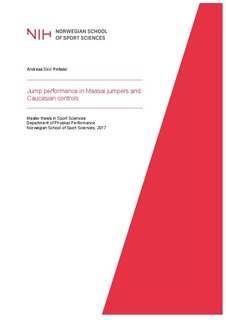| dc.description.abstract | Purpose: The purpose of the present thesis was to investigate countermovement jump (CMJ) performance, muscle-tendon morphology and anthropometrics in Tanzanian Maasai individuals and to compare these data to Caucasian controls. Methods: 28 healthy subjects (Maasai = 20, Caucasian = 8) volunteered for the study. Maximal CMJ performance was evaluated by use of force plate kinetics and kinematics. Timing of muscle activation was examined with electromyography (EMG). Moreover, anthropometric data for the lower leg was acquired, and muscle architecture and tendon dimensions were assessed by use of ultrasound (US). Finally, jump height and joint angles were estimated for the Maasai while performing a traditional ‘jump dance ritual’. Results: Relative to body height the Maasai had greater foot (P < 0.001) and hallux length (P = 0.019). The Maasai had shorter lower legs compared to the Caucasians in absolute values (P = 0.033) and displayed shorter fascicles and lower muscle thickness for gastrocnemius (GM) and vastus lateralis (VL) both in absolute (GM fascicle length: P < 0.001, VL fascicle length: P < 0.001, GM thickness: P < 0.001, VL thickness: P < 0.001) and relative values (GM fascicle length: P < 0.001, VL fascicle length: P = 0.002, GM thickness: P < 0.001, VL thickness: P = 0.003). Achilles tendon (AT) aponeurosis length was greater in the Maasai compared to the controls both in absolute (P = 0.042) and relative values (P = 0.005). Relative to body height AT and AT moment arm length were significantly greater for the Maasai (AT length: P = 0.014, AT moment arm: P = 0.017). CMJ hip flexion was significantly greater (P < 0.001) in the control group. Jump height in CMJ were significantly lower for the Maasai in absolute values (Maasai: 33.3 ± 6.6 cm vs. Caucasian: 40.0 ± 4.9 cm, P = 0.015), but relative to body weight (BW) jump height was greater in the Maasai group (Maasai: 0.6 ± 0.1 vs. Caucasian: 0.5 ± 0.1, P = 0.009). Duration of the braking and push-off phases were significantly (P < 0.001) in the Maasai subjects compared to the Caucasian controls. The EMG-data demonstrated overall ‘wider’ signals for the Maasai group compared to the controls. For 18 Maasai subjects, average jump height during a so-called ‘jump dance ritual’ was 46 cm. Jump height during the ‘jump dance ritual’ correlated positively to BW (r = 0.68) and CMJ height (r = 0.69). Conclusion: The Maasai subjects jumped higher in maximal CMJ compared to Caucasian controls when adjusting for BW, and practiced a more upright jumping strategy compared to the controls. In maximal CMJ, the time duration of the braking and push-off phases were shorter for the Maasai subjects. Fascicle length and muscle thickness were less in GM and VL for the Maasai group both in absolute and relative values. The Maasai subjects had a longer AT, AT aponeurosis and AT moment arm relative to body height compared to the controls. Furthermore, jump height during the ‘jump dance ritual’ for the Maasai was remarkable and close to 50 cm. The present study is the first to incorporate precise biomechanical methodology to investigate jumping performance in Maasai individuals, and the results underscore previous notions that the Maasai show good jump performance. The study demonstrates clear differences in anthropometry between groups and combined with the Maasai lifestyle (consisting of traditional jumping rituals and a high volume of daily activity) it sheds light on the factors that underlie the impressive jumping capabilities in Maasai individuals. The Maasai possess significant jumping performance despite no specific strength or plyometric training history as common in western world jumping athletes. | nb_NO |
